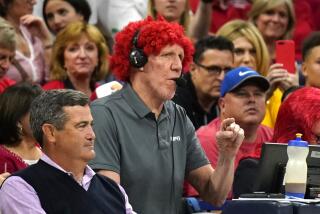He scored 188 points so his coach could make one
- Share via
Wilt Chamberlain scored 100 points in a game and was immortalized.
Kobe Bryant scored 81 and was lionized.
John Barber, a 6-foot-6 center who played at Cal State Los Angeles in the early 1950s, scored more than the two of them combined -- in a game that was eight minutes shorter, no less -- and was marginalized, his feat thought to be so unworthy and unbelievable that his alma mater did little to preserve it.
“You can see why I don’t want to go around talking about it with my friends,” Barber, 74, tells a visitor to his home in the Morningside Park area of Los Angeles. “Nobody wants to believe it, and I can understand that.”
But understand this: It’s true.
On Feb. 16, 1953, in a 208-82 victory for the Cal State L.A. varsity over the Chapman College junior varsity, Barber scored a staggering 188 points, the result of an “experiment” concocted by his coach, Sax Elliot, to debunk the myth of Clarence “Bevo” Francis as a “Superman” of the courts.
Francis at the time was attracting national attention for his prodigious scoring exploits at Rio Grande College in Rio Grande, Ohio. Against a schedule that included 27 of 39 games against noncollegiate teams (vocational schools, junior colleges and service teams), Francis averaged 50.1 points a game in the 1952-53 season, topped by a 116-point effort against Ashland Junior College.
Elliot, described as an inventive and inquisitive coach, wanted to see whether Barber could top Francis’ single-game mark if asked to do nothing but score.
He set up a game against the Chapman JV to find out.
“Sax Elliot was the type that liked to experiment,” Barber says of his former coach, whose other “innovations” included fitting players with shoes that featured springy, inches-thick soles. “He believed in challenging every little thing, and he was always in my corner. Boy, he thought I could do anything.
“So Sax came up with the idea that any great scorer could score that many points if he’s fed the ball often enough, and he set out to prove it.”
Barber was a self-described country boy who had come to Los Angeles from his tiny hometown of Atlanta, Texas, hoping to play football at UCLA for legendary coach Red Sanders. When it was discovered that he was not academically eligible, he enrolled instead at East Los Angeles College.
An all-conference two-way end, Barber spent barely a year in junior college before landing a scholarship at what was then known as Los Angeles State, where he lettered in football, basketball and track and twice was the school’s athlete of the year. In basketball, he was a two-time All-California Collegiate Athletic Assn. pick and twice led the conference in scoring, averaging 22.5 points over two seasons.
Against the Chapman JV, Barber was instructed by Elliot to stay near the basket, shoot the ball virtually every time he touched it and expend little or no energy playing defense. Barber says he rarely ventured beyond the midcourt line.
“Me being a high jumper,” notes Barber, who says he cleared 6 feet 6 inches in the event despite no formal training, “if you threw the ball anywhere near the basket I could funnel it or stuff it or whatever. I could jump my height, you see, so I could get up there, and a lot of times I got fouled in the process of shooting. I did most of the shooting, and I had a decent jump shot and a terrific hook shot, once I got into position. I’m not bragging on myself. It’s just true.”
Though the point totals amassed by Los Angeles State and Barber eclipsed anything Rio Grande and Francis had managed, “the Coast school promptly disclaimed them as true competitive records,” according to an article published later that year in the NCAA rules and records book.
Later, the NCAA Rules Committee ratified a vote by the National Basketball Coaches Assn. that only games between varsity teams of four-year, degree-granting colleges would be recognized as collegiate contests.
“This long-needed legislation was briefly labeled by the press as ‘anti-Bevo,’ ” the NCAA rules and record book article noted, “although it really was the Los Angeles State-Chapman tilt that jolted the cage authorities out of their lethargy.”
In Los Angeles, a team of disbelieving sportswriters challenged Los Angeles State to a game. Barber scored 150 points against the hapless scribes.
Barber played briefly in the NBA -- five games with the St. Louis Hawks in the 1956-57 season -- but quickly tired of “collecting splinters” on the bench and, more hurtful, dealing with overt racism from fans and teammates.
He barnstormed for several years with Goose Tatum’s Harlem All-Stars, described by Barber as a better-paying outfit than the Harlem Globetrotters, and later was a recreation director in Los Angeles for more than 20 years. Now retired, he has been married for nearly 55 years. He and his wife, Mary, are grandparents.
A basketball purist, he does not believe he was cheated out of a record. “You don’t just play offense,” says Barber, whose milestone game is not even noted on his plaque in his alma mater’s athletic hall of fame. “You’ve got to help both ways.”
He understands the doubters.
“Anyone would be skeptical unless they could see it happen,” he says of his mind-boggling scoring spree. “But if they could see it, they would know that it’s quite possible. It can be done.”


